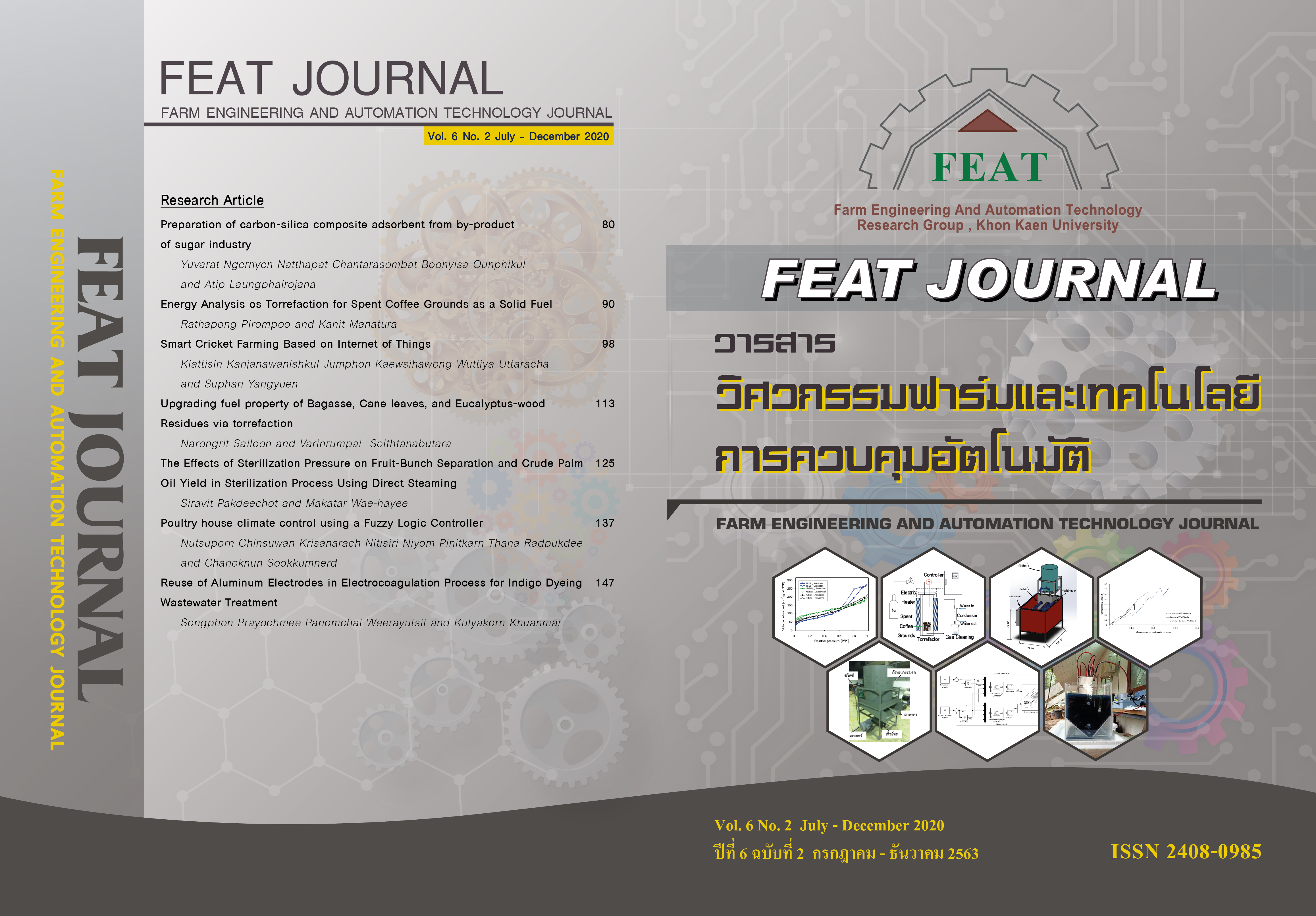การใช้ซ้ำของขั้วไฟฟ้าอลูมิเนียมในกระบวนการตกตะกอนทางไฟฟ้า เพื่อบำบัดน้ำเสียย้อมคราม
Main Article Content
บทคัดย่อ
งานวิจัยนี้มีวัตถุประสงค์เพื่อศึกษาการใช้ซ้ำของขั้วไฟฟ้าอลูมิเนียมในกระบวนการตกตะกอนทางไฟฟ้าเพื่อบำบัดน้ำเสียจากการย้อมคราม การทดลองดำเนินการในระดับห้องปฏิบัติการและในระดับอุตสาหกรรมขนาดเล็ก โดยใช้ขั้วไฟฟ้าอลูมิเนียมความหนา 0.5 มิลลิเมตร นอกจากนี้ได้ศึกษาค่าใช้จ่ายในการบำบัดน้ำเสียจากการย้อมครามด้วยกระบวนการตกตะกอนทางไฟฟ้า การกำหนดปัจจัยในกระบวนการตกตะกอนทางไฟฟ้าประกอบด้วย ระยะเวลาในการทำปฏิกิริยา 60 นาที ความหนาแน่นของกระแสไฟฟ้า 300 แอมป์แปร์/ตารางเมตร ค่า pH ในการทดลองระดับห้องปฏิบัติการที่ pH 11 และไม่มีการปรับค่า pH ในการทดลองกับถังปฏิกรณ์ต้นแบบ พบว่า การใช้ซ้ำ 3 ครั้ง ยังคงรักษารูปทรงสี่เหลี่ยมของขั้วไฟฟ้าด้านที่มีการละลายคือ แอโนด ไว้เหมือนด้านที่ไม่มีการละลายคือ แคโทด การทดลองใช้ถังปฏิกรณ์ต้นแบบในการบำบัดน้ำเสียจริงจากการย้อมครามในอุตสาหกรรมขนาดเล็ก พบว่า ประสิทธิภาพการบำบัดซีโอดีและสีเฉลี่ยร้อยละ 76.75 และ 76.39 ตามลำดับ สำหรับการใช้ขั้วไฟฟ้าด้านแอโนดซ้ำ 3 ครั้ง มีค่าใช้จ่ายประมาณ 1,426.22 บาทต่อน้ำเสีย 1 ลูกบาศก์เมตร หากการใช้ซ้ำของขั้วด้านแอโนดจนละลายหมด มีค่าใช้จ่ายประมาณ 169.59 บาท ต่อน้ำเสีย 1 ลูกบาศก์เมตร
Article Details
วารสารวิศวกรรมฟาร์มและเทคโนโลยีควบคุมอัตโนมัติ (FEAT Journal) มีกําหนดออกเป็นราย 6 เดือน คือ มกราคม - มิถุนายน และกรกฎาคม - ธันวาคม ของทุกปี จัดพิมพ์โดยกลุ่มวิจัยวิศวกรรมฟาร์มและเทคโนโลยีควบคุมอัตโนมัติ คณะวิศวกรรมศาสตร์มหาวิทยาลัยขอนแก่น เพื่อเป็นการส่งเสริมและเผยแพร่ความรู้ ผลงานทางวิชาการ งานวิจัยทางด้านวิศวกรรมศาสตร์และเทคโนโลยีพร้อมทั้งยังจัดส่ง เผยแพร่ตามสถาบันการศึกษาต่างๆ ในประเทศด้วย บทความที่ตีพิมพ์ลงในวารสาร FEAT ทุกบทความนั้นจะต้องผ่านความเห็นชอบจากผู้ทรงคุณวุฒิในสาขาที่เกี่ยวข้องและสงวนสิทธิ์ ตาม พ.ร.บ. ลิขสิทธิ์ พ.ศ. 2535
References
Erkan G, Sengül K, Kaya S. Dyeing of white and indigo dyed cotton fabrics with Mimosa tenuiflora extract. Journal of Saudi Chemical Society. 2014; 18(2): 139–48.
Lellis B, Fávaro-Polonio CZ, Pamphile JA, Polonio JC. Effects of textile dyes on health and the environment and bioremediation potential of living organisms. Biotechnology Research and Innovation. 2019; 3(2): 275–90.
Secula MS, Crežescu I, Petrescu S. An experimental study of indigo carmine removal from aqueous solution by electrocoagulation. Desalination. 2011; 277(1–3): 227–35.
Albuquerque LF, Salgueiro AA, Melo JLDS, Chiavone-Filho O. Coagulation of indigo blue present in dyeing wastewater using a residual bittern. Separation and Purification Technology. 2013; 104: 246–9.
Hu Y, Chen X, Liu Z, Wang G, Liao S. Activated carbon doped with biogenic manganese oxides for the removal of indigo carmine. Journal of Environmental Management. 2016; 166: 512–8.
Zhu X, Bao L, Wei Y, Ma J, Kong Y. Removal of toxic indigo blue with integrated biomaterials of sodium carboxymethyl cellulose and chitosan. International Journal of Biological Macromolecules. 2016; 91: 409–15.
Naciri N, et al. Effective photocatalytic decolorization of indigo carmine dye in Moroccan natural phosphate-TiO2 aqueous suspensions. Opt Mater (Amst) 2016; 52: 38–43.
Emamjomeh MM, Sivakumar M. Review of pollutants removed by electrocoagulation and electrocoagulation/flotation processes. Journal of Environmental Management. 2009; 90(5): 1663–79.
Anfruns-Estrada E, Bruguera-Casamada C, Salvadó H, Brillas E, Sirés I, Araujo RM. Inactivation of microbiota from urban wastewater by single and sequential electrocoagulation and electro-Fenton treatments. Water Research. 2017; 126: 450–9.
Elazzouzi M, Haboubi K, Elyoubi MS. Electrocoagulation flocculation as a low-cost process for pollutants removal from urban wastewater. Chemical Engineering Research and Design. 2017; 117: 614–26.
Elazzouzi M, El Kasmi A, Haboubi K, Elyoubi MS. A novel electrocoagulation process using insulated edges of Al electrodes for enhancement of urban wastewater treatment: Techno-economic study. Process Saf Environ Prot. 2018; 116: 506–15.
Deghles A, Kurt U. Treatment of tannery wastewater by a hybrid electrocoagulation/electrodialysis process. Chemical Engineering and Processing: Process Intensification. 2016; 104: 43–50.
Moradi M, Moussavi G. Enhanced treatment of tannery wastewater using the electrocoagulation process combined with UVC/VUV photoreactor: Parametric and mechanistic evaluation. Chemical Engineering Journal. 2019; 358 (April 2018): 1038–46.
Camcioglu S, Ozyurt B, Hapoglu H. Effect of process control on optimization of pulp and paper mill wastewater treatment by electrocoagulation. Process Safety and Environmental Protection 2017; 111: 300–19.
Khorram AG, Fallah N. Treatment of textile dyeing factory wastewater by electrocoagulation with low sludge settling time: Optimization of operating parameters by RSM. Journal of Environmental Chemical Engineering. 2018; 6(1): 635–42.
Hendaoui K, Ayari F, Rayana I Ben, Amar R Ben, Darragi F, Trabelsi-Ayadi M. Real indigo dyeing effluent decontamination using continuous electrocoagulation cell: Study and optimization using Response Surface Methodology. Process Safety and Environmental Protection. 2018; 116: 578–89.
Zazou H, Afanga H, Akhouairi S, Ouchtak H, Addi AA, Akbour RA, et al. Treatment of textile industry wastewater by electrocoagulation coupled with electrochemical advanced oxidation process. Journal of Water Process Engineering. 2019; 28(February): 214–21.
Bilinska L, Blus K, Gmurek M, Ledakowicz S. Coupling of electrocoagulation and ozone treatment for textile wastewater reuse. Chemical Engineering Journal. 2019; 358(October 2018): 992–1001.

